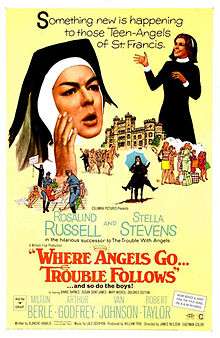Where Angels Go, Trouble Follows
| Where Angels Go, Trouble Follows | |
|---|---|
 Theatrical release poster | |
| Directed by | James Neilson |
| Produced by | William Frye |
| Screenplay by | Blanche Hanalis |
| Story by | Jane Trahey |
| Starring |
Rosalind Russell Stella Stevens Mary Wickes |
| Narrated by | Rosalind Russell |
| Music by |
Bobby Hart Lalo Schifrin Tommy Boyce |
| Cinematography | Sam Leavitt |
| Edited by | Adrienne Fazan |
Production company | |
| Distributed by | Columbia Pictures |
Release dates |
|
Running time | 93 minutes |
| Country | United States |
| Language | English |
| Box office | $1.4 million (rentals)[1] |
Where Angels Go, Trouble Follows is a 1968 American comedy film directed by James Neilson and starring Rosalind Russell, Stella Stevens, and Binnie Barnes. Written by Blanche Hanalis, (who would go on to develop Little House on the Prairie five years later), the film is based on a story by Jane Trahey about an old-line Mother Superior who is challenged by a modern young nun when they take the girls of St. Francis Academy on a bus trip across the United States.
Released on April 10, 1968, Where Angels Go, Trouble Follows is a sequel to The Trouble with Angels (1966). Russell, Mary Wickes, Binnie Barnes and Dolores Sutton all reprise their roles as nuns from the original film. Wickes would later don the habit yet again for her amusing turn in both Sister Act (1992) and the sequel, Sister Act 2: Back in the Habit (1993).
Plot
The story depicts the rivalry between the conservative Mother Superior (Russell) and the glamorous, progressive young Sister George (Stevens) as they shepherd a busload of Catholic high school girls across America to an interfaith youth rally being held in Santa Barbara, California. As they debate expressions of faith and role of the Church in the tumultuous America of the sixties, they must also contend with the antics of two rebellious, trouble-prone students, Rosabelle (Susan Saint James) and Marvel Anne (Barbara Hunter).
Cast
- Rosalind Russell as Mother Superior
- Stella Stevens as Sister George
- Binnie Barnes as Sister Celestine
- Mary Wickes as Sister Clarissa
- Dolores Sutton as Sister Rose-Marie
- Milton Berle as Film Director
- Arthur Godfrey as The Bishop
- Van Johnson as Father Chase
- Robert Taylor as Mr. Farraday
- Susan Saint James as Rosabelle
- Barbara Hunter as Marvel Anne
- Alice Rawlings as Patty
- Hilary Thompson as Hilarie
- Devon Douglas as Devon
- Ellen Moss as Tanya
- Cherie Lamour as Cherie
- June Fairchild as June[2]
Production
Casting
Along with Russell, the three featured nuns from The Trouble with Angels (Mary Wickes as Sister Clarissa, Binnie Barnes as Sister Celestine and Dolores Sutton as Sister Rose-Marie) returned for this outing. Barbara Hunter also reprised her role as Marvel Anne, the cousin of Hayley Mills' character (despite having been seen in the graduation line-up at the finale of the first film). The remarkable supporting cast includes Milton Berle (as a bombastic John Ford style movie director), Arthur Godfrey (as the Bishop of the diocese where the St. Francis Academy is located), Van Johnson (as the head of a Catholic boys high school) and Robert Taylor (as a wealthy rancher in his final film).
Filming locations
- Germantown Academy, 340 Morris Road, Fort Washington, Pennsylvania, USA
- Dorney Amusement Park, 3830 Dorney Park Road, Allentown, Pennsylvania, USA
- Eaves Movie Ranch, 75 Rancho Allegre Santa Fe, New Mexico, USA
- Independence National Historical Park, Philadelphia, Pennsylvania, USA
- Pennsylvania Turnpike, Pennsylvania, USA
Many of the scenes in the movie's first half were filmed in Philadelphia, including Market Street near 13th Street, a couple of blocks west, right outside City Hall, and a protest scene at the Philadelphia Museum of Art. Also, at the northern suburbs of Philadelphia and the Lehigh Valley, especially at was St. Mary's Villa, a Catholic home for troubled and at-risk youth on Bethlehem Pike in Ambler, Pennsylvania.
The "boarding school" at which the group stops was actually Germantown Academy, about 2 miles (3.2 km) south of St. Mary's Villa, although the church shown just prior to the boarding school is actually Ft. Washington Baptist Church, which is only about 1 mile (1.6 km) northeast of St. Mary's Villa. A scene prominently displays Dorney Park, an amusement park in Allentown, Pennsylvania.
The early bus scenes were filmed in nearby Fort Washington, Pennsylvania and along the Pennsylvania Turnpike, with the exception of the scene where the bus (which bears an appropriate Pennsylvania license plate) stalls at a railroad crossing and is nearly hit by a Santa Fe train (which does not serve the Philadelphia area).
Soundtrack
The theme song was written and performed on the soundtrack by pop act and songwriting duo Boyce & Hart. Composer Lalo Schifrin, best known for his work on the television series Mission: Impossible, collaborated with Boyce & Hart on the title song and supplied the incidental score.
- "Where Angels Go, Trouble Follows" (Schifrin, Boyce, and Hart) performed by Tommy Boyce & Bobby Hart – 1:59
- "Goodbye Baby (I Don't Want to See You Cry)" (Schifrin, Boyce, and Hart) performed by Tommy Boyce & Bobby Hart – 2:57[3]
See also
References
- ↑ "Big Rental Films of 1968", Variety, 8 January 1969, pg 15.
- ↑ "Where Angels Go, Trouble Follows!". Turner Classic Movies. Retrieved March 3, 2016.
- ↑ "Where Angels Go, Trouble Follows (1968)". Soundtrack Collector. Retrieved June 8, 2012.
External links
- Where Angels Go, Trouble Follows! at the Internet Movie Database
- Where Angels Go, Trouble Follows! at the TCM Movie Database
- Where Angels Go, Trouble Follows! at AllMovie
- Where Angels Go, Trouble Follows at the American Film Institute Catalog